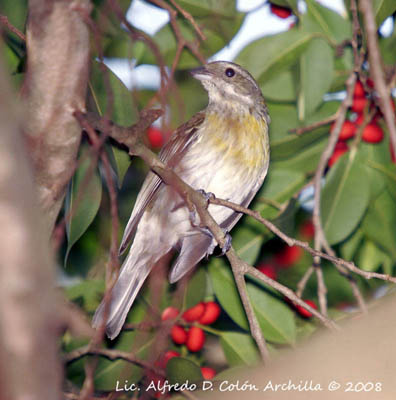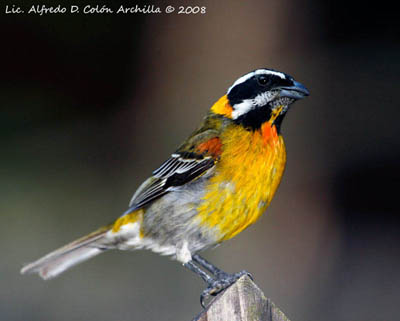
Puerto Rican Spindalis
Spindalis portoricensis
Passeriforme Order - Thraupidae Family
BIOMETRICS :
Length: 17 cm; Weight: M: 22 to 37 g – F: 28 to 41 g
DESCRIPTION:
Puerto Rican Spindalis is endemic to Puerto Rico. Male and female are very different in plumage coloration.
Adult male has yellow-green upperparts in shoulders, mantle and rump. Wings and tail are blackish with whitish edges.
On the underparts, breast and upper belly are yellow-orange. Lower belly, vent and undertail coverts are greyish-white. Undertail feathers are greyish and the tail is graduated. Underwing is pale grey.
Puerto Rican Spindalis has black head, with two conspicuous white stripes, one as long supercilium extending to the nape, and the other from the lower base of the bill, as malar stripe. Chin and throat are black, with vertical yellow-orange stripe in the centre, joining the breast. Nape shows an orange half-collar, joining the white malar stripe.
The strong bill is blackish, slightly decurved. Lower mandible is white with black tip. Eyes are dark brown to blackish, with black lores. Legs and feet are dark grey.
Female is duller than male overall. Upperparts are similar, but duller. She has buffy-white underparts, streaked with brown on throat, breast, belly and flanks. Vent is whitish.
Head is greyish-brown, with indistinct white supercilium, and white malar stripe. Nape shows dull yellow half-collar. Chin is whitish.
Bill, eyes, legs and feet are similar to those of the male.
We find three other similar species:
S. nigicephala from Jamaica;
S. dominicensis, from Hispaniola;
And the western race S. zena from the Bahamas, Cuba and Caribbean islands of Mexico.
The four species differ in plumage coloration and songs.
It is resident in its range, and only performs short-distance flight to the feeding areas. These birds travel in pairs or in small groups.
Puerto Rican Spindalis feeds mainly on fruits and berries, often high in the canopy.
By its movements from fruiting trees to other areas, it brings seeds of forest plants through the island.
Puerto Rican Spindalis moves through a dense vegetated area by grasping plants with the bill, and swinging from one to another without help of wings or feet. (Sources: The Wilson Journal of Ornithology – 2006).
FLIGHT:
Puerto Rican Spindalis performs bouncing flight with alternated wing beats and glides.
Photographs by Alfredo Colón
Puerto Rico Wildlife
Text by Nicole Bouglouan
Sources:
A GUIDE TO THE BIRDS OF MEXICO AND NORTHERN CENTRAL AMERICA by Steve N. G. Howell, Sophie Webb - Oxford University Press - ISBN: 0198540124
Wikipedia (Wikipedia, The Free Encyclopedia)

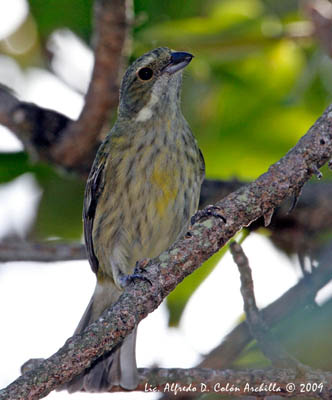
VOICE: SOUNDS BY XENO-CANTO
Puerto Rican Spindalis male utters high-pitched notes from high perches.
Female utters “whisper songs” when perched close to the ground in dense vegetation.
Typical song is a long series of high-pitched notes in regular pattern. We can also hear a rapid “tweet” and a short “chi chi chi”.
HABITAT:
Puerto Rican Spindalis is common throughout the island in humid forests, plantations and orchards, but also in urban areas. It can be seen at all altitudes, but rarely higher than 1000 metres.
RANGE:
Puerto Rican Spindalis is resident and endemic to Puerto Rico.
BEHAVIOUR:
Puerto Rican Spindalis is territorial and it will defend strongly its territory. Male can attack its own reflection in a window as a rival, and try to fight with it.
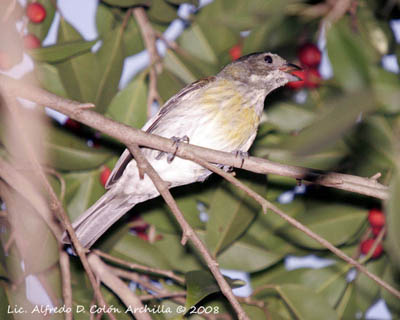
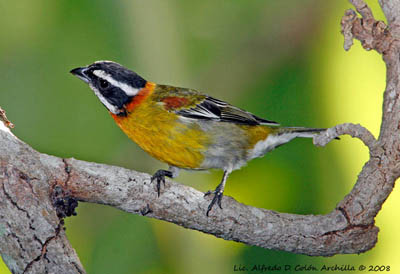
REPRODUCTION:
Puerto Rican Spindalis builds a cup-shaped nest, but it can be small, bulky or deep. It is made with plant materials.
Female lays 2 to 4 pale blue eggs, with brown markings.
Nesting behaviour is unknown at this moment.
These birds defend strongly nest, eggs and chicks against predators. As other species, Puerto Rican Spindalis engages in mobbing behaviour, attacking and harassing a potential predator, as avian or terrestrial. Several birds gather around a presumed dangerous predator.
DIET:
Puerto Rican Spindalis feeds mainly on ripe fruits and berries of several varieties of plants, such as figs and blackberries. It also catches insects, aphids and small lizards, and takes nectar from flowers.
PROTECTION / THREATS / STATUS:
Puerto Rican Spindalis is common in Puerto Rico, and its populations are not globally threatened at this moment.
Spanish name: Reina Mora - Frutero de Puerto Rico
